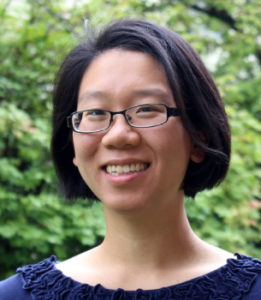
Elizabeth Shogren, reporting for The Center for Investigative Reporting’s Reveal, first interviewed climate scientist Maria Caffrey in 2013. At that time, Caffrey had just started a new and timely research project for the National Park Service. She was looking at how climate change would affect future storm surges and flooding in 118 national parks along the coastal U.S., from Massachusetts’s Cape Cod National Seashore to California’s Golden Gate National Recreation Area.
Caffrey got the idea when park officials asked her to estimate flood depths at the Statue of Liberty after Hurricane Sandy hit in October 2012. This was information Caffrey thought the Park Service would have already had on hand—not only for the Statue of Liberty but for all coastal national parks and monuments, Caffrey later told Shogren in “Silencing Science,” an in-depth radio story for Reveal.
Caffrey pitched her idea to the Park Service and got funding to model future climate-change impacts on coastal national parks. Her findings, which Park Service press releases said would publish in May 2017, would have far-reaching implications for how to manage the U.S.’s national parks, about a quarter of which are near or along the coast.
But in 2017, the report was nowhere to be seen.
When Shogren followed up with Caffrey in February 2018, she was surprised to be punted to a Park Service spokesperson who told her the report was still going through internal review. Shogren also saw that Caffrey, who had been open to talking with her in the past, had posted in October 2017 on her personal blog that she had no idea when her sea-level and storm-surge report would be released and that she had to “scale back” on communications regarding future climate-change research.
Shogren, knowing the Trump administration’s track record of climate-change denial and its skeptical attitude toward climate science, decided to investigate. She had a hunch that she was inquiring about government-censored science—despite then Interior Department Secretary Ryan Zinke’s statement to Congress that the department was not interfering with science.
Shogren obtained 18 versions of Caffrey’s study through a Colorado state records request. The tracked changes in the documents showed that the Park Service employees reviewing Caffrey’s report were erasing references to human-caused climate change. These findings culminated in the story “Wipeout: Human Role in Climate Change Removed from Science Report,” for Reveal, in April 2018.
Shogren also sued the National Park Service to release public records of emails between Caffrey and the park officials reviewing Caffrey’s study. The back-and-forth exchange became part of “Silencing Science,” which looked at how federal officials tried to pressure Caffrey to accept the Park Service’s changes to the report.
After Shogren’s initial story broke, House and Senate Democrats called on the Interior Department’s internal watchdog, the Inspector General’s office, to investigate. The National Park Service quietly released the uncensored report on its website about a month later, in May 2018.
How does one begin reporting when the sources can’t or won’t talk? Here, Shogren tells Jennifer Lu how she found this story and got access to the suppressed Park Service reports, and what readers can learn from her reporting process. (This interview has been edited for length and clarity.)
How did you begin reporting this story?
My initial efforts to find out what happened to the report were not very effective. The report’s lead researcher, Maria Caffrey, was a University of Colorado scientist who was working under a contract with the National Park Service. I reached out to the researcher, who had been very open in the past, but she was on maternity leave and she pushed me off to a public information officer.
Around the same time, I found [Caffery’s personal] website, which basically said in a very subtle way that [her] work was being suppressed.
With that, I knew that it was time to start putting in a public-records request, just to see what was happening.
What records requests did you file for this story?
Because [Caffrey] was a scientist at the University of Colorado, I was able to put in a public-records request through the State of Colorado, which has an open-records law, and through the Freedom of Information Act (FOIA) with the National Park Service.
I sent in a FOIA request to the National Park Service asking for drafts of the report and emails and other communications related to the report. It took a really long time to get any responses from the federal government and we eventually sued. And I repeated the request so I would continue to get information after the [initial] request. So that came in a couple different batches.
Then there was [a parallel request to] the University of Colorado under the Colorado Open Records Act (CORA). They responded much more quickly, but they wanted a lot of money to search for the emails. The Freedom of Information Act request [process] waives fees for journalists in many cases, but Colorado didn’t. So we found a way to make it easier for them: [The request] was narrowed down to the drafts of the report, and they produced those rather quickly.
How did you word your records requests? Did you need to know the name of the report?
The research was not a secret. They had talked about this research on the National Park Service website. It was clear that this research was ongoing. It had an official name that wasn’t really that hard to look for through a Freedom of Information Act request.
I started off broadly and then I narrowed it down. In this case, I knew the particular name of the researcher who was doing the research. And so I wanted emails to [Caffrey] and from [Caffrey] that used the terms “sea-level rise” and “storm surge,” among other key words.
How did you compare the different versions of the draft report? Did you have to read everything, or is there a tool for that?
It took a lot of reading. But a lot of (the drafts) were Word documents so you could see in the tracked changes what was being edited. And you can use the search function to search for words that might lead you to important and interesting findings. Pretty quickly it became clear that what was at risk in the reports were references to humans causing climate change.
How do you know whether you got all the draft versions of the report?
I guess you never know, but you know what you got, so you can report about that. The university provided 18 reports, and this is what they showed.
What other tools did you use during your reporting?
There’s something called the Silencing Science Tracker [out of Columbia Law School’s Sabin Center for Climate Change Law]. They have been gathering examples of science being censored over time. And that provided context for [my] story.
There are also a lot of cool ways to use the Internet for your benefit. There’s something called the Wayback Machine, which helps you search past versions of websites, and a research project called EDGI (Environmental Data and Governance Initiative), which tracks how federal government websites change. [EDGI is an international network of people from academic institutions and nonprofit groups, as well as volunteers, concerned about the erasure of environmental and other federal information from government data after the 2016 presidential election.]
You’re based in Washington, DC. Were you able to talk in person with some of your federal sources?
Unfortunately, a lot of [Park Service] officials were not based in DC. But I tried very hard to talk to people in person. And mostly I got “nos.”
For the radio [program], I went to parks that were highlighted by the researchers for being at great risk from sea-level rise and storm surge. I went to the National Mall, and it happened that it was a well-timed visit, with Hurricane Florence on the way to land[fall].
Then I went to Canaveral National Seashore, because I had been told that Maria Caffrey’s data was being used by a different scientist to try to figure out the risk from sea-level rise and storm surge for the sea turtles that nest along that beach. When there’s a big hurricane, all the eggs get washed away, so you can lose the next crop of sea turtles, and this very long stretch of beaches is very important for these species. I went there and interviewed park officials there, too. And that was, I think, very revelatory in the story, because you get a sense of just how uncomfortable they are with the whole issue of climate change.
[And] there was more suppression [of science]: The scientist who’s doing that research on turtles? The National Park Service told her not to talk to me. She had arranged an interview with me, and at the last minute she pulled out. She had been told not to do it.
What advice do you have for journalists in terms of getting federal documents and other information that’s difficult to obtain?
I think it’s important to think strategically: Is there a way to try to get this information through other sources? Was the government dealing with outside scientists that work for public institutions? Those responses will come back much more quickly, and I’ve seen that in other people’s reporting, not just mine. It’s a really big lesson that I took from this and I’ve been sharing it with other reporters.
Then, I think that some of it is just shoe-leather reporting. One of the things that I think has always been something that [I’ve done] as a reporter, whether as an investigative reporter or not, is to try to go directly to the sources who have this information.
And then if they can’t help you, there’s always people who used to be involved in that program or whatever it is that you’re working on. Sometimes you can find another network of former EPA officials, former National Park Service officials, [etc.]. I talked to scientists and former park officials and superintendents about their concerns about what they saw on the ground, and sea-level rise and storm surges we’re already seeing. Most of that didn’t get into the stories themselves, but it informed my reporting.
It’s very difficult for people who are currently in government to help you, but sometimes they can, so you shouldn’t stop trying. Try to find out the people who are involved firsthand and try to find a way to get directly to them.

Jennifer Lu is an environmental journalist and TON early-career fellow sponsored by the Burroughs Wellcome Fund. Her work has appeared in National Geographic, Popular Science, Audubon, and more. Jennifer can be found on Twitter @jenpenned.


